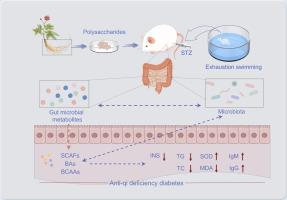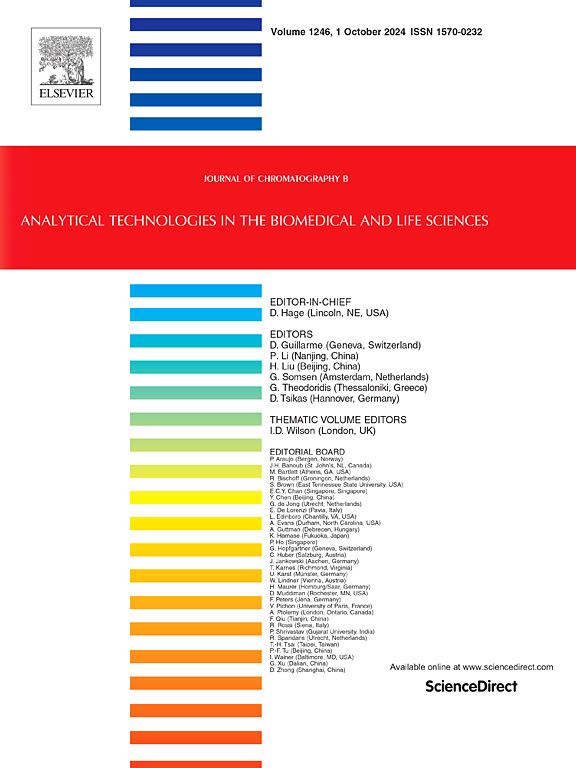Therapeutic effects of Panax ginseng polysaccharides on qi deficiency diabetes: Insights from microbiomics and metabolomics
IF 2.8
3区 医学
Q2 BIOCHEMICAL RESEARCH METHODS
引用次数: 0
Abstract
Panax ginseng, a traditional medicinal and edible plant valued for its tonifying properties, exhibits diverse pharmacological activities, including anti-fatigue, anti-oxidation and anti-diabetes. Polysaccharides represent a key active ingredient of Panax ginseng, known for their immunomodulatory properties and potential for development as health foods. However, the effect and mechanism of Panax ginseng polysaccharides (GP) on improving qi deficiency diabetes (QDD) is still unclear. In this study, a multi-omics approach integrating microbiomics, untargeted and targeted metabolomics was used to elucidate the protective effect and mechanisms of GP based on the QDD rat model. Furthermore, the prebiotic effects of GP were explored through microbiome and metabolome profiling. GP demonstrated significant therapeutic efficacy in QDD rats, manifested by the amelioration of hyperlipidemia and insulin resistance, reduction of oxidative stress, enhancement of immune responses, and restoration of intestinal injury. Untargeted fecal metabolomics and 16S rRNA gene sequencing revealed that GP significantly altered the abundance of 31 metabolites and corrected gut microbiota dysbiosis in QDD rats. Additionally, GP ameliorated bile acid metabolism disorders, significantly increased short-chain fatty acids (SCFAs) levels, and reduced branched-chain amino acids (BCAAs) concentrations. Spearman correlation analysis further confirmed significant associations between gut microbes and metabolites. Thus, GP exerts its therapeutic effect on QDD by ameliorating intestinal flora imbalance and associated metabolic disorders involving bile acids, branched-chain amino acids, and short-chain fatty acids. Together, these findings provide a foundation for the further development of GP-based functional foods.

人参多糖对气虚型糖尿病的治疗作用:来自微生物学和代谢组学的见解
人参是一种具有滋补功效的传统药用和食用植物,具有抗疲劳、抗氧化、抗糖尿病等多种药理活性。多糖是人参的一种关键活性成分,以其免疫调节特性和发展为保健食品的潜力而闻名。然而,人参多糖(GP)对气虚型糖尿病(QDD)的改善作用及其机制尚不清楚。本研究基于QDD大鼠模型,采用微生物组学、非靶向代谢组学和靶向代谢组学相结合的多组学方法,阐明GP的保护作用及其机制。此外,通过微生物组和代谢组分析探讨了GP的益生元效应。GP对QDD大鼠表现出明显的治疗效果,表现为改善高脂血症和胰岛素抵抗,降低氧化应激,增强免疫反应,恢复肠道损伤。非靶向粪便代谢组学和16S rRNA基因测序显示,GP显著改变了QDD大鼠31种代谢物的丰度,并纠正了肠道微生物群失调。此外,GP改善了胆汁酸代谢紊乱,显著增加了短链脂肪酸(SCFAs)水平,降低了支链氨基酸(BCAAs)浓度。Spearman相关分析进一步证实了肠道微生物与代谢物之间的显著相关性。由此可见,GP对QDD的治疗作用是通过改善肠道菌群失衡及相关的胆胆酸、支链氨基酸和短链脂肪酸代谢紊乱来实现的。总之,这些发现为进一步开发以gp为基础的功能性食品提供了基础。
本文章由计算机程序翻译,如有差异,请以英文原文为准。
求助全文
约1分钟内获得全文
求助全文
来源期刊

Journal of Chromatography B
医学-分析化学
CiteScore
5.60
自引率
3.30%
发文量
306
审稿时长
44 days
期刊介绍:
The Journal of Chromatography B publishes papers on developments in separation science relevant to biology and biomedical research including both fundamental advances and applications. Analytical techniques which may be considered include the various facets of chromatography, electrophoresis and related methods, affinity and immunoaffinity-based methodologies, hyphenated and other multi-dimensional techniques, and microanalytical approaches. The journal also considers articles reporting developments in sample preparation, detection techniques including mass spectrometry, and data handling and analysis.
Developments related to preparative separations for the isolation and purification of components of biological systems may be published, including chromatographic and electrophoretic methods, affinity separations, field flow fractionation and other preparative approaches.
Applications to the analysis of biological systems and samples will be considered when the analytical science contains a significant element of novelty, e.g. a new approach to the separation of a compound, novel combination of analytical techniques, or significantly improved analytical performance.
 求助内容:
求助内容: 应助结果提醒方式:
应助结果提醒方式:


